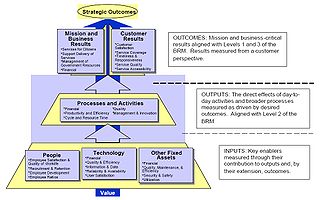Performance measurement
This article focuses only on one specialized aspect of the subject. (December 2011) |
Performance measurement is the process of collecting, analyzing and/or reporting information regarding the performance of an individual, group, organization, system or component. It can involve studying processes/strategies within organizations, or studying engineering processes/parameters/phenomena, to see whether output are in line with what was intended or should have been achieved.
Performance measurement in education
Performance measurement has been defined by Neely[1] as “the process of quantifying the efficiency and effectiveness of past actions”, while Moullin[2] defines it as "the process of evaluating how well organisations are managed and the value they deliver for customers and other stakeholders”. Discussion on the relative merits of these definitions appeared in several articles in the newsletter of the Performance Management Association.[3]
Good performance is the criterion whereby an organization determines its capability to prevail.
Performance measurement estimates the parameters under which programs, investments, and acquisitions are reaching the targeted results.[4]

All process of measuring performance requires the use of statistical modeling to determine results. A full scope copy of the performance of an organization can never be obtained, as generally some of the parameters cannot be measured directly but must be estimated via indirect observation and as a complete set of records never delivers an assessment without compression to key figures.
Several performance measurement systems are in use today, and each has its own group of supporters. For example, the Balanced Scorecard (Kaplan and Norton, 1993, 1996, 2001), Performance Prism (Neely, 2002), and the Cambridge Performance Measurement Process (Neely, 1996) are designed for business-wide implementation; and the approaches of the TPM Process (Jones and Schilling, 2000), 7-step TPM Process (Zigon, 1999), and Total Measurement Development Method (TMDM) (Tarkenton Productivity Group, 2000) are specific for team-based structures. With continued research efforts and the test of time, the best-of-breed theories that help organizations structure and implement its performance measurement system should emerge.
Although the Balanced Scorecard has become very popular, there is no single version of the model that has been universally accepted. The diversity and unique requirements of different enterprises suggest that no one-size-fits-all approach will ever do the job. Gamble, Strickland and Thompson (2007, p. 31) list ten financial objectives and nine strategic objectives involved with a balanced scorecard.
Performance measurement in engineering
Performance measurement are carried out in the design, building, operation and maintenance of systems, machines, devices, structures, materials and processes. In design, performance measurement can be of physical properties, parameters, etc., while in maintenance, repair, and operations, and reliability engineering, failures, downtime, uptime, maintainability and OEE are common measures.
See also
- Performance improvement
- Performance metric
- List of financial performance measures
- Library assessment
References
- ^ Neely, A.D., Adams, C. and Kennerley, M. (2002), The Performance Prism: The Scorecard for Measuring and Managing Stakeholder Relationships, Financial Times/Prentice Hall, London
- ^ Moullin, M. (2002), Delivering Excellence in Health and Social Care, Open University Press,Buckingham
- ^ Moullin, M. (2007) Performance measurement definitions. Linking performance measurement and organisational excellence, International Journal of Health Care Quality Assurance,20:3,pp. 181-183.
- ^ Office of the Chief Information Officer (OCIO) Enterprise Architecture Program (2007). Treasury IT Performance Measures Guide. U.S. Department of the Treasury. May 2007
- ^ FEA Consolidated Reference Model Document. whitehouse.gov May 2005.
3. (Robert D. Behn 2003) Why measure Performance? Different Purposes Require Different Measures.
Further reading
- Gamble, J., Strickland, A., Thompson, A. (2007). Crafting & Executing Strategy. (15th Ed.) New York, McGraw-Hill
- Simon Briscoe. 2005. The trouble with targets. OECD Observer, no. No. 246-247.
- Kaplan, Robert S. and David P. Norton; "Putting the Balanced Scorecard to Work", Harvard Business Review, Sep/Oct 1993.
- Hutton, C.R.; Performance Measures Briefing Paper.
- Ittner, Christopher D. and David F. Larcker, "Coming up Short on Nonfinancial Performance Measurement", Harvard Business Review, November 2003.
- Kaplan, Robert S. and Norton, David P; "The Balanced Scorecard: Measures That Drive Performance", Harvard Business Review, Jan/Feb 1992.
- Kaplan, Robert S. and Norton, David P; "Using the Balanced Scorecard as a Strategic Management System", Harvard Business Review, Jan/Feb 1996.
- Kirby, Julia, "Towards a Theory of High Performance", Harvard Business Review, Jul/Aug 2005.
- Mendibil, Kepa and Macbryde Jillian; "Designing effective team-based performance measurement systems: an integrated approach", Centre for Strategic Manufacturing, University of Strathclyde, James Weir Building, March 2005.
- Meyer, Christopher, "How the Right Measures Help Teams Excel", Harvard Business Review, May/June 1994.
- National Partnership for Reinventing Government, USA; Balancing Measures: Best Practices in Performance Management, August 1999.
- Rohm, Howard; Overview of the Balanced Scorecard, US Foundation for Performance Measurement, June 2000.
- Schacter, Mark. 2002. Not a Tool Kit. Practitioner's Guide to Measuring the Performance of Public Programs. Institute On Governance. http://schacterconsulting.com/docs/toolkit.pdf.
- Schacter, Mark. 2008. When Performance Targets Miss the Mark. The Globe and Mail, March 31. http://schacterconsulting.com/documents/targets.pdf.
- Van de Walle, Steven and Roberts, Alasdair, "Publishing Performance Information: An Illusion of Control?" Performance Information in the Public Sector: How it is Used, Van Dooren, W., Van de Walle, S., eds., Houndmills: Palgrave, pp. 211–226, 2008.
- Bacon, Carl, "Practical Portfolio Performance Measurement and Attribution" September 2004, 240 pages
- Grau, Micah E., 2008. "Using a Model Municipal Performance Measurement System to Assess Mid-size Texas Cities' Systems" . Applied Research Projects. Paper 282. http://ecommons.txstate.edu/arp/282
